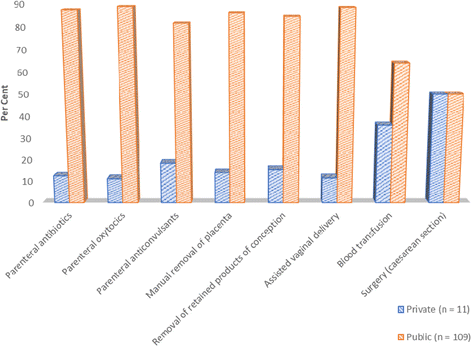Review of emergency obstetric care interventions in health facilities in the Upper East Region of Ghana: a questionnaire survey
- PMID: 29544489
- PMCID: PMC5855967
- DOI: 10.1186/s12913-018-2980-6
Review of emergency obstetric care interventions in health facilities in the Upper East Region of Ghana: a questionnaire survey
Abstract
Background: Maternal morbidity and mortality is most prevalent in resource-poor settings such as sub-Saharan Africa and southern Asia. In sub-Saharan Africa, Ghana is one of the countries still facing particular challenges in reducing its maternal morbidity and mortality. Access to emergency obstetric care (EmOC) interventions has been identified as a means of improving maternal health outcomes. Assessing the range of interventions provided in health facilities is, therefore, important in determining capacity to treat obstetric emergencies. The aim of this study was to examine the availability of emergency obstetric care interventions in the Upper East Region of Ghana.
Methods: A cross-sectional survey of 120 health facilities was undertaken. Status of emergency obstetric care was assessed through an interviewer administered questionnaire to directors/in-charge officers of maternity care units in selected facilities. Data were analysed using descriptive statistics.
Results: Eighty per cent of health facilities did not meet the criteria for provision of emergency obstetric care. Comparatively, private health facilities generally provided EmOC interventions less frequently than public health facilities. Other challenges identified include inadequate skill mix of maternity health personnel, poor referral processes, a lack of reliable communication systems and poor emergency transport systems.
Conclusion: Multiple factors combine to limit women's access to a range of essential maternal health services. The availability of EmOC interventions was found to be low across the region; however, EmOC facilities could be increased by nearly one-third through modest investments in some existing facilities. Also, the key challenges identified in this study can be improved by enhancing pre-existing health system structures such as Community-based Health Planning and Services (CHPS), training more midwifery personnel, strengthening in-service training and implementation of referral audits as part of health service monitoring. Gaps in availability of EmOC interventions, skilled personnel and referral processes must be tackled in order to improve obstetric outcomes.
Keywords: Emergency obstetric care; Ghana; Health facility review; Maternal mortality; Obstetric complications; Signal functions.
Conflict of interest statement
Ethics approval and consent to participate
Ethics approval for this study was obtained from Navrongo Health Research Centre, Ghana (NHRCIRB189) and Victoria University, Melbourne, Australia (HRE14–074). Written informed consent was obtained from all respondents before the interviews commenced.
Consent for publication
Not applicable.
Competing interests
The authors declare that they have no competing interests.
Publisher’s Note
Springer Nature remains neutral with regard to jurisdictional claims in published maps and institutional affiliations.
Figures
Similar articles
-
The availability of emergency obstetric care in the context of the JSY cash transfer programme in Madhya Pradesh, India.BMC Pregnancy Childbirth. 2016 May 18;16(1):116. doi: 10.1186/s12884-016-0896-x. BMC Pregnancy Childbirth. 2016. PMID: 27193837 Free PMC article.
-
Skilled birth attendants in Tanzania: a descriptive study of cadres and emergency obstetric care signal functions performed.Matern Child Health J. 2015 Jan;19(1):155-69. doi: 10.1007/s10995-014-1506-z. Matern Child Health J. 2015. PMID: 24791974
-
Emergency obstetric and neonatal care availability, use, and quality: a cross-sectional study in the city of Lubumbashi, Democratic Republic of the Congo, 2011.BMC Pregnancy Childbirth. 2017 Jan 19;17(1):40. doi: 10.1186/s12884-017-1224-9. BMC Pregnancy Childbirth. 2017. PMID: 28103822 Free PMC article.
-
Barriers to access and utilization of emergency obstetric care at health facilities in sub-Saharan Africa: a systematic review of literature.Syst Rev. 2018 Nov 13;7(1):183. doi: 10.1186/s13643-018-0842-2. Syst Rev. 2018. PMID: 30424808 Free PMC article.
-
Strengthening emergency obstetric care in Ayacucho, Peru.Int J Gynaecol Obstet. 2006 Mar;92(3):299-307. doi: 10.1016/j.ijgo.2005.12.005. Epub 2006 Jan 25. Int J Gynaecol Obstet. 2006. PMID: 16442113 Review.
Cited by
-
Epidemiology of cerebral palsy among children in Ghana.Afr J Disabil. 2024 Sep 20;13:1336. doi: 10.4102/ajod.v13i0.1336. eCollection 2024. Afr J Disabil. 2024. PMID: 39364205 Free PMC article.
-
Assessing the functionality of an emergency obstetric referral system and continuum of care among public healthcare facilities in a low resource setting: an application of process mapping approach.BMC Health Serv Res. 2021 Apr 29;21(1):402. doi: 10.1186/s12913-021-06402-7. BMC Health Serv Res. 2021. PMID: 33926425 Free PMC article.
-
Perspectives of healthcare workers on the challenges with obstetric referrals in rural communities in Ghana: a descriptive phenomenology study.BMJ Open. 2023 Apr 13;13(4):e066910. doi: 10.1136/bmjopen-2022-066910. BMJ Open. 2023. PMID: 37055200 Free PMC article.
-
Quality and women's satisfaction with maternal referral practices in sub-Saharan African low and lower-middle income countries: a systematic review.BMC Pregnancy Childbirth. 2020 Nov 11;20(1):682. doi: 10.1186/s12884-020-03339-3. BMC Pregnancy Childbirth. 2020. PMID: 33176732 Free PMC article.
-
Intended Pregnancy as a Predictor of Good Knowledge on Birth Preparedness and Complication Readiness: the Case of Northern Ethiopia Pregnant Mothers.Int J Reprod Med. 2019 Jan 21;2019:9653526. doi: 10.1155/2019/9653526. eCollection 2019. Int J Reprod Med. 2019. PMID: 30805355 Free PMC article.
References
-
- World Health Organization . Trends in maternal mortality: 1990 to 2013. Estimates by WHO, UNICEF, UNFPA, the World Bank and the United Nations population division. Geneva: WHO; 2014.
-
- UNFPA . Giving birth should not be a matter of life and death giving birth should not be a matter of life and death. 2012.
Publication types
MeSH terms
Grants and funding
LinkOut - more resources
Full Text Sources
Other Literature Sources
Medical


